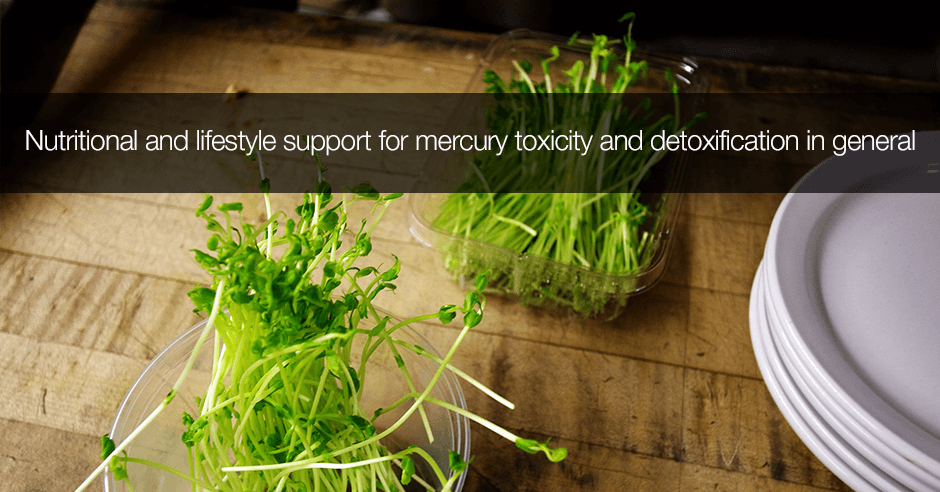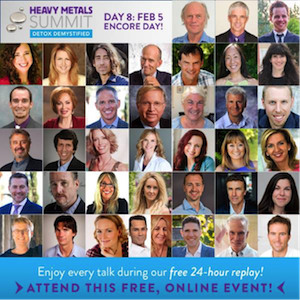
I’ve poured through most of the transcripts of the Heavy Metals Summit and there is so much information on nutritional and lifestyle support for mercury toxicity and the detoxification process in general:
- sweating and using a sauna in order to detox through the skin
- broccoli sprouts (due to a glutathione boost from sulforaphane, an organosulfur compound – in Julie Matthews’s interview)
- reducing EMF/ELF and microwave exposure – in Dr. Mercola’s talk! He shares how all this can make matters worse and has some simple approaches like turning off power in the bedroom at night! This was new to me and a brilliant approach!
- eating organic (to minimize GMO/glyphosate effects on a leaky gut and a leaky blood brain barrier) and never using Roundup
- addressing low zinc and low selenium
- supporting methylation so the body can detox on it’s own
- supporting the liver and increasing bile production which is needed for detoxification
- addressing low stomach acid which is needed for bile production and absorption of minerals like zinc (which is depleted by heavy metals)
- avoiding meds like PPIs (which reduce stomach acid) and NSAIDs (which contribute to leaky gut)
- thyroid support/iodine (as needed)
- getting the brain’s glymphatic system working with sufficient sleep, melatonin (liposomal) and even liposomal GABA (in Dr. Christine Schaffer’s interview)
- supporting the vagus nerve in order to improve digestion and detoxification
- using an air filter and water filters
- using foods/products like curcumin, ginger, probiotics, apple pectin
- adding DPP-4 enzyme for gluten issues (mercury depletes this)
- avoid energy-efficient bulbs (they are high mercury)
- having Epsom salts baths
- improving elimination from the bowels and much more
This is the support I offer as a nutritionist and it’s wonderful to hear all these doctors/practitioners discuss about all this with a tie back to mercury, lead and other metals.
Whey is not mentioned on the summit but since someone shared how it’s benefiting her (in the comments of the Boyd Haley blog) I’m sharing here too since it helps with glutathione production. In this paper “a case is made for the use of hydrolyzed whey protein to support metal detoxification and neurological function.” I recommend whey to clients if tolerated.
Many years ago I heard a presentation by a biological dentist who then became a nutritionist – he shared that he used whey with mercury toxic patients (together with other nutrients) and saw metals go up in hair analysis and then come down as their symptoms improved.
As I’ve mentioned in the past, mercury chelation is a controversial topic and you’ll see comments very divided on what the safest approach is. This is not my area of expertise and I’m very cautious with recommendations in this area as I’ve had reports of harm from individuals using all the approaches you’ll hear about on the summit (and even the Andy Cutler protocol which is not covered). My best advice is to follow all the nutritional/lifestyle recommendations and if you do decide to go the chelation root, do your homework, find a practitioner to work with and listen to your gut. If what you’re doing doesn’t feel right then stop doing it.
As with any chronic health condition, mercury detox is a comprehensive approach and very individualized.
There is also a discussion about safe removal of amalgams/mercury fillings. They do need to be done safely so as not to cause further issues. The IOMT also offers excellent guidelines.
The summit also covers other metals like copper (Ann Louise Gittleman covers this and I blog about it here), arsenic (Dr. Joseph Pizzorno covers this – reducing consumption is a big factor; and non-organic chicken is a source) and aluminum.
You can still register here to hear day 7 interviews and the encores: The Heavy Metals Summit.
Have you seen benefits with a nutritional approach?

I have a generous serving of broccoli sprouts with almost every meal – is that enough to create the glutathione boost or do you think one needs to supplement with glutathione as well?
Drew
That’s wonderful! Is it enough to provide the glutathione boost you need? It’s hard to know as there are so many factors – like what toxins you’re dealing with, how well you detox, inflammation etc. Typically when someone is dealing with health challenges we do need more support than we get from diet alone.
Thanks Trudy – yes, good points – will bear your wisdom in mind…
Please realize that not all energy efficient light bulbs contain mercury. The ones to avoid in residential use are primarily compact fluorescent lamps [CFLs] and fluorescent tubes [even more mercury than CFLs!] LEDs do not contain mercury.
“Old school” bulbs, or incandescent are not really safe either. We are finding that the tungsten used make them last longer is also a toxic metal that we should avoid.
In commercial use, also avoid metal halide, high-pressure sodium, and mercury vapor lights [of course]. All of these contain mercury.
All of these [except LEDs] need to be disposed of as hazardous waste [by law]; never put them in the trash or dispose of in a landfill or dump. Most cities and counties in the US have hazardous waste disposal facilities that often are free, although some require an appointment to dispose of the hazardous waste at their facility.
Michael
Thanks for sharing these valuable insights! I did not know about the tungston issue – no one talks about this!
So in summary, what do we need to look for in the store – in terms of healthy products and unhealthy products? is this correct?
Ok products: LEDs (any comments on the reports they can damage the eyes?)
Not ok products due to tungston: “Old school” bulbs, or incandescent
Not ok products due to mercury: compact fluorescent lamps [CFLs] and fluorescent tubes [even more mercury than CFLs!]; metal halide, high-pressure sodium, and mercury vapor lights (I don’t really know what the latter are?)
I haven’t seen any definitive studies on LEDs damaging the eyes. I would like to see more and better studies before I can evaluate this issue. We have to be careful that hearsay on the internet is not interpreted as fact until we have definitive proof. Some information is disseminated by commercially- vested interests trying to protect their products and market. Monsanto is an excellent example of this. And other than maiming and killing people, it’s the only thing Monsanto is good at, in my opinion.
There are however, studies showing that light in the blue spectrum suppresses melatonin production and should be avoided in the evening and late night if you have problems falling and staying asleep.
Studies showing tungsten as a carcinogen have been definitive in animal studies. That’s good enough for me to want to avoid it, if possible. There are also other health problems related to tungsten, but these are mostly caused by occupational exposures where the amount of exposure is greater than in the general population. A Google search for “tungsten toxicity” will provide more information. HHS has released a toxicological profile for tungsten but the research is not up to date and the government tends to be slow in updating their data to reflect the latest research.
The last three lighting products I mentioned [metal halide, high-pressure sodium and mercury vapor] are all high-intensity discharge [HID] lights typically used outside in commercial applications for security, parking lot, and walkway lighting. Metal halide are the most common today with a bright white look that fades to a sickly greenish color as they age. High-presure sodium are the really yellow ones that are bright but make it hard to see colors correctly since it has more light in the yellow and orange spectrum and very little blue. Mercury vapor, still seen as street and parking lot lighting in older towns and on farms, is the one with the bluish glow to it.
A little more on the mercury-containing lighting products: I often hear people say they believe they can safely use CFLs and fluorescent tubes, and as long as they don’t break them and dispose of them properly, they don’t have to be concerned about the mercury contained in them. Wrong! I used to believe that too!
As a lighting professional, I have received cases of CFLs and fluorescent tubes that were contaminated with the white phosphorescent coating from inside of the tubes [contains mercury] even though none were broken in that case. So just handling the product that was shipped with broken tubes can be a strong potential source of mercury contamination for you. Always wash your hands as soon as possible after handling mercury-containing lighting products, and especially before rubbing your eyes, picking your nose or eating and drinking.